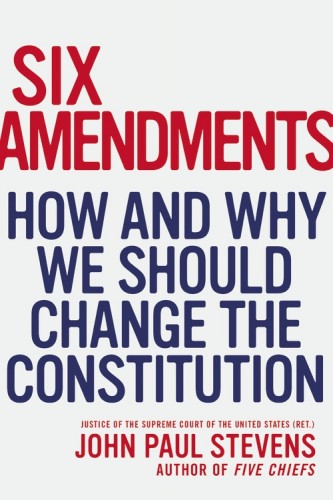Book Review: “Six Amendments” — Is U.S. Constitutional Change in the Air?
Retired Associate Justice John Paul Stevens’ book Six Amendments is unlikely to restore any of the love lost between him and the GOP.
Six Amendments: How and Why We Should Change the Constitution, by John Paul Stevens. Little, Brown and Company, 256 pages, $25.
By Blake Maddux
Associate Justice John Paul Stevens retired from the United States Supreme Court in June 2010 at age 90. His 34-½ years on the bench stands as the third-longest tenure in the history of the Court. Stevens’s predecessor in the seat that he assumed in November 1975 belonged immediately before him to William Orville Douglas, the longest-serving Justice in American history.
Unlike Douglas, who had been severely incapacitated by a stroke almost a full year before he grudgingly tendered his resignation, Stevens was as mentally spry as he had ever been when he retired. He published his first book – the tersely titled Five Chiefs – nearly a year-and-a-half after hanging up his robe. Having looked back on the five Chief Justices with whom he worked most closely, Stevens now (at age 94) looks forward to making Six Amendments to the Constitution of the United States.
Some on the political right have complained that choices for the Supreme Court become more liberal once they are on the bench than the nominating President expected them to be. This goes back at least as far as Dwight D. Eisenhower’s (perhaps apocryphal) remark that he made two major mistakes as President and they were both on the Supreme Court. More recently, when it came time for George W. Bush to select a new member for the high court, people joked, “Gonzalez is Spanish for Souter.” They feared that, if appointed, Attorney General Alberto Gonzalez would turn out to be a liberal like the departing David Souter did. (Justice Souter, whom I once encountered on the sidewalk outside of Pizzeria Uno in Harvard Square, was nominated by George H.W. Bush to replace William Brennan, one of Ike’s “mistakes.”)
Similarly, Republican Gerald R. Ford nominated Republican John Paul Stevens, whom commentators came to consider the leader of the Court’s liberal bloc in the later years of his service. (He spent 15 years as senior Associate Justice.) Conservative writer W. James Antle – with whom I was roommates in college – once wrote, “No more David Souters. And no more John Paul Stevens Republicans.”
Six Amendments is unlikely to restore any of the love lost between Stevens and the GOP.
However much conservatives might want to reduce gun violence, they do no want to do so by limiting the right to bear arms to individuals “when serving in the militia,” which are the words with which Stevens would modify the Second Amendment.
Moreover, death penalty advocates do not think that methods such as lethal injection are “cruel and unusual” or that the forfeiture of one’s life for the most heinous of crimes is or should be unconstitutional. After all, the Constitution twice mentions that an individual will not be deprived of “life, liberty, or property, without due process of law.”
Thus, life is one of the things of which one may be constitutionally deprived if he or she is afforded due process. Rendering the death penalty unconstitutional would therefore require not only adding “such as the death penalty” to the Eight Amendment, as Stevens suggests, but removing “life” from the Fifth and Fourteenth Amendments, which Stevens fails to mention.
While many of Stevens’s points in favor of his suggested amendments are articulate and well-buttressed by legal history, there are some other wobbly spots in the book’s overall architecture.
At one point, Stevens writes, “A legal rule should not persist merely because of its unmerited longevity. That gerrymandering has a long history does not counsel in its favor.” In a subsequent chapter, Stevens quotes the estimable Justice Oliver Wendell Holmes, Jr., as having written in 1898, “It is revolting to have no better reason for a rule of law than that it was so laid down in the time of Henry IV.”
However, Stevens’s cases against recent SCOTUS decisions pertaining to campaign finance and individual gun ownership are based almost wholly on the Court’s having overturned longstanding statutes or precedents. On campaign finance, Stevens asserts, “the first opinions written by any member of the Court arguing that the corporate expenditures in elections campaigns are entitled to the same constitutional protection as the activity of individual voters were not announced until 1990.”
Regarding guns, he writes, “For over two hundred years following the adoption of that [the Second] amendment federal judges uniformly understood that…it applied only to keeping and bearing arms for military purposes…”
To those who voted in the majority in these cases, the longevity of the precedents and prior understandings were unmerited — because merit is in the eye of the beholder.
By Stevens’s own admission, the fact that the Court thought differently for a really long time does not render that previous line of thinking invincible. The sage retired Justice would have been better off had he explicitly referenced the importance of adherence to precedent (stare decisis), but that method is itself not bulletproof.
Furthermore, there is at least one instance in which Stevens relies on a specious (mis)understanding of the Supreme Court’s bailiwick. Commenting in chapter one on the decision that instituted the “anti-commandeering” rule, Stevens asserts that the majority opinion “had little to say about the practical consequences of a decision limiting the power of the federal government to respond to problems with a national dimension.”
As the branch of government with the final say on constitutionality, the Supreme Court is not in the business of deciding whether a law should stand or fall because it is good or bad or because its doing one or the other will have desirable or undesirable consequences. Rather, as the relatively obscure but surprisingly quotable Justice Potter Stewart (the guy who knew pornography when he saw it) wrote in a 1965 dissent, “we are not asked in this case to say whether we think this law is unwise, or even asinine. We are asked to hold that it violates the United States Constitution.”
Stewart was in a minority of two in this case, but he clearly understood his responsibility. A good Justice, he was saying, should be able to say to him or herself, “This law is uncommonly silly [words that Stewart also used in that dissent], unenforceable [ditto], unwise, and asinine. However, none of these pejoratives—individually or in combination—necessarily add up to unconstitutionality.”
Thus, Stevens’s interpretation of the majority as having given short shrift to “the practical consequences” of their decision does nothing to undermine the constitutionality of the law that was under consideration.
Six Amendments contains plenty of legal history and discussions of Supreme Court B-sides to satisfy judicial branch aficionados, but no one will find all of the chapters to be equally stimulating. However, that was probably also true of Five Chiefs, which turned out to be a bestseller. The author’s cred, meanwhile, surely will not be adversely affected by his recently declared belief that marijuana should be legal and the fact that he is included on the “with us” end of the “Threat Assessment” spectrum in the current issue of Rolling Stone.
I admire that Stevens suggests the ambitious project of amending the Constitution. The fact that this process is so cumbersome renders such changes more legitimate than a 5-4 SCOTUS decision or an along-party-lines act of Congress. I also appreciate Stevens’s optimism when he says, “As time passes, I am confident that the soundness of each of my proposals will become more and more evident, and that ultimately each will be adopted.”
Although six seems like quite a few, given that there have been only 27 amendments in all of American history (10 of which – the Bill of Rights – were adopted in one fell swoop), we are probably due for a few since only one has been approved in more than 40 years. After all, some simple addition and division of the numbers that Stevens presents in the Prologue reveal that a new amendment has appeared once every 11.8235 years between the adoption of the Bill of Rights in 1791 the passage of Amendment XXVII in 1992.
Blake Maddux is a freelance journalist and regular contributor to DigBoston and The Somerville Times. He recently received a master’s degree from Harvard Extension School, which awarded him the Dean’s Thesis Prize in Journalism. A native Ohioan, he moved to Boston in 2002 and currently lives with his wife in Salem, Massachusetts. He will be teaching a class during the spring term on the First Amendment in American History at the Cambridge Center for Adult Education in Cambridge, MA.



